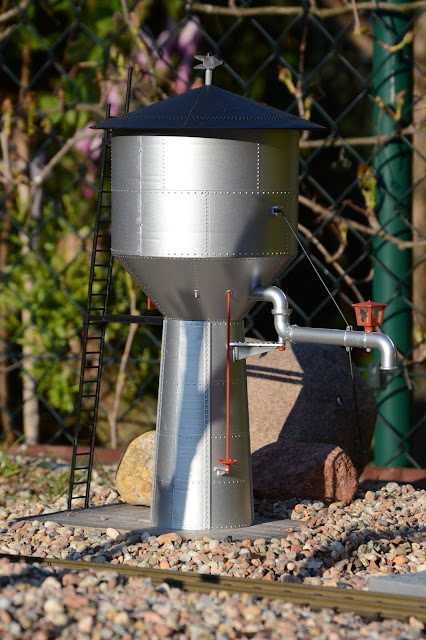The article I've bought this time is Pola G 330922. It's a G-scale model of a railway water tower featuring a steel finish appearance. The product is no longer in production and is difficult to find at the moment. But knowing Pola G - they'll probably have a re-run sooner or later.
It comes in a rather small and light-weighted box.
There isn't very much inside. After all, it's not a big model. But one thing that is easily noticeable is how carefully the parts are packaged. Most of the bigger elements are separately wrapped in a protective paper and all of them have a clearly defined place in the box.
The manual is just 4 pages long but it is also very clear. The fact that every part is tagged definitely helps here.
Here are all the structure parts. The "steel" elements are very shiny and easily catch one's attention. A base element is included but unfortunately it feels very light. The set does not include any glue.
And here are the remaining parts. We get one sticker and two functional elements:
- a rubber pipe which allows the model to have a real water flowing through its body
- electrical wires with a light bulb that will illuminate the discharge pipe and its surroundings
Unlike the houses I usually assemble, the water tower is meant to be built simply from the bottom to the top. There are no preparation steps where one would - for example - create wall elements first. It's really refreshing not to follow the usual pattern for once.
As already mentioned the tower model features electrical and water functions. Those are located inside the spout and this fact has to be taken into account during the build.
There's a water storage element which goes inside the tower. It features a discharge mechanism controlled by a long rod. To use it one fills the container with water and unscrews the rod. This also requires that the roof part is not glued to the tower body, so it can be removed to allow a re-fill.
Once complete, the model looks very nice.
The supplied light element is a very welcome addition. Unfortunately it's a traditional light bulb and not an LED but that's fine. The more surprising fact is how strong the light is. The manual never mentions what voltage should be used to drive the light. I've just assumed the usual 16V. At this voltage it's just too bright for me...
...especially considering how thin the lantern part is. The light just shoots right through it. I'm definitely installing a resistor to decrease the illumination power.
I have to make a comment about the water function, too. Personally I find it useless and that is for two reasons:
- I can hardly imagine any railroad fan actually making the effort to fill the tower with water just to see it going out. It might be fun once or twice but I don't believe anyone would keep doing this regularly.
- The function requires the roof part not to be glued to the body. In my case it did not work that well. On the first windy night the roof flew away together with the small wind vane piece. Luckily I found them but the problem repeated the next night, too. After that, I've decided to glue the roof element for good.
Other than that, it's a very nice addition to my garden layout. Looks really cool next to my rural train station.
































